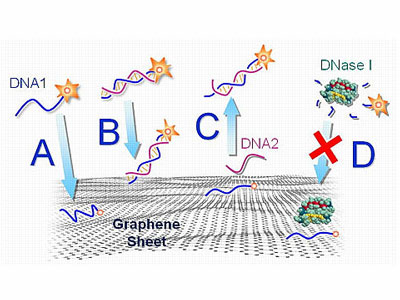| Posted: Apr 25, 2013 | |
Carbon-based nanotechnology materials for biomedical engineering |
|
| (Nanowerk Spotlight) Carbon nanomaterials such as nanotubes or graphene not only are widely researched for their potential uses in industrial applications, they also are of great interest to biomedical engineers working on nanotechnology applications. These researchers found that incorporating carbon-based nanomaterials (CBN) is effective not only as injectable nanoscale devices but also as components to enhance the function of existing biomaterials significantly. | |
| Nitrogen-doped carbon nanotubes (CNTs) for instance have been developed for drug delivery applications ("Nanoparticle-corked carbon nanotubes as drug delivery vehicles"); nanodiamonds have been used as a novel gene delivery technology that combines key properties in one approach: enhanced delivery efficiency along with outstanding biocompatibility ("Nanomedicine promises safer gene therapy with nanodiamonds"); and graphene has been demonstrated to provide a promising biocompatible scaffold that does not hamper the proliferation of human mesenchymal stem cells and accelerates their specific differentiation into bone cells ("Graphene used in biomedical applications can control the fate of stem cells"). | |
| These are just a few examples of a rapidly growing body of research of using CBNs in biomedical engineering. A new article ("Carbon-Based Nanomaterials: Multifunctional Materials for Biomedical Engineering"), just published online in ACS Nano, highlights different types of carbon-based nanomaterials currently used in biomedical applications. | |
| Led by Ali Khademhosseini, an Associate Professor at Harvard-MIT's Division of Health Sciences and Technology, Brigham and Women’s Hospital and Harvard Medical School, the authors focus on carbon nanotubes and graphene and their applications in many areas of biomedical engineering, including drug delivery systems, tissue scaffold reinforcements, and cellular sensors. | |
| Carbon nanotubes | |
| "There is considerable interest in using CNTs for various biomedical applications. The physical properties of CNTs, such as mechanical strength, electrical conductivity, and optical properties, could be of great value for creating advanced biomaterials. Carbon nanotubes can also be chemically modified to present specific moieties (e.g., functional groups, molecules, and polymers) to impart properties suited for biological applications, such as increased solubility and biocompatibility, enhanced material compatibility and cellular responsiveness." | |
| The authors then go on to describe in more detail CNT applications as cell and tissue labeling agents; injectable drug delivery systems; and biomaterial reinforcements. | |
| They also address the issue of cytotoxicity of CNTs, an area that has already attracted much research interest (see for instance "Conflicting risk data complicates the use of carbon nanotubes as neural interfaces" or "Comparing apples with oranges - the problem of nanotubes risk assessment"). Given the inconclusive state of these nanotoxicology studies, they are left to conclude, like so many other researchers, that "more systematic biological evaluations of CNTs having various chemical and physical properties are warranted in order to determine their precise pharmacokinetics, cytotoxicity, and optimal dosages." | |
| Graphene | |
| Research into utilizing graphene for biomedical applications has been limited to date, as graphene research itself is still in its infancy. Researchers have made some progress, though. They have shown that graphene and DNA can combine to create a stable and accurate biosensor ("Graphene-DNA biosensor selective, simple to create"). | |
 |
|
| An illustration of how fluorescent-tagged DNA interacts with functionalized graphene. Both single-stranded DNA (A) and double-stranded DNA (B) are adsorbed onto a graphene surface, but the interaction is stronger with ssDNA, causing the fluorescence on the ssDNA to darken more. C) A complimentary DNA nears the ssDNA and causes the adsorbed ssDNA to detach from the graphene surface. D) DNA adsorbed onto graphene is protected from being broken down by enzymes. | |
| Graphene and graphene derivatives have also been explored in biomedicine due to their exceptional chemical and physical properties. In previous work, researchers have made the surprising finding that graphene-based nanomaterials – graphene oxide, graphene oxide and reduced graphene oxide – possess excellent antibacterial properties (see for instance: "Antibacterial paper made from graphene"). They discovered that the toxicity mechanism of graphene-based nanomaterials includes oxidative stress, physical piercing through the sharp edges of graphene nanowalls, as well as photothermal heating. This has led to studies that explore if it is possible to replace antibiotics with graphene-based photothermal agents. | |
| Other carbon-based nanomaterials | |
| In their final chapter, the authors look at fullerenes (C60) and nanodiamonds and highlight some studies that explore their use in biomedical engineering. | |
| Concluding their article, Khademhosseini and his co-authors state that they expect to see continued use of carbon-based nanomaterials in many facets of biomedical engineering. | |
| "In particular, there is great promise in applying the biocompatible and multifunctional nature of CBNs to the areas that interconnect mechatronics and biology, such as microelectromechanical systems (MEMS) for biological sensors and actuators. Furthermore, more recent studies suggest that CBNs may also be used to regulate cellular behavior. Although research efforts have largely been focused on utilizing CNTs, other types of CBNs – especially graphene, which has gained wide recognition in recent years – are expected to be investigated extensively in the near future." | |
 By
Michael
Berger
– Michael is author of three books by the Royal Society of Chemistry:
Nano-Society: Pushing the Boundaries of Technology,
Nanotechnology: The Future is Tiny, and
Nanoengineering: The Skills and Tools Making Technology Invisible
Copyright ©
Nanowerk LLC
By
Michael
Berger
– Michael is author of three books by the Royal Society of Chemistry:
Nano-Society: Pushing the Boundaries of Technology,
Nanotechnology: The Future is Tiny, and
Nanoengineering: The Skills and Tools Making Technology Invisible
Copyright ©
Nanowerk LLC
|
|
|
Become a Spotlight guest author! Join our large and growing group of guest contributors. Have you just published a scientific paper or have other exciting developments to share with the nanotechnology community? Here is how to publish on nanowerk.com. |
|
